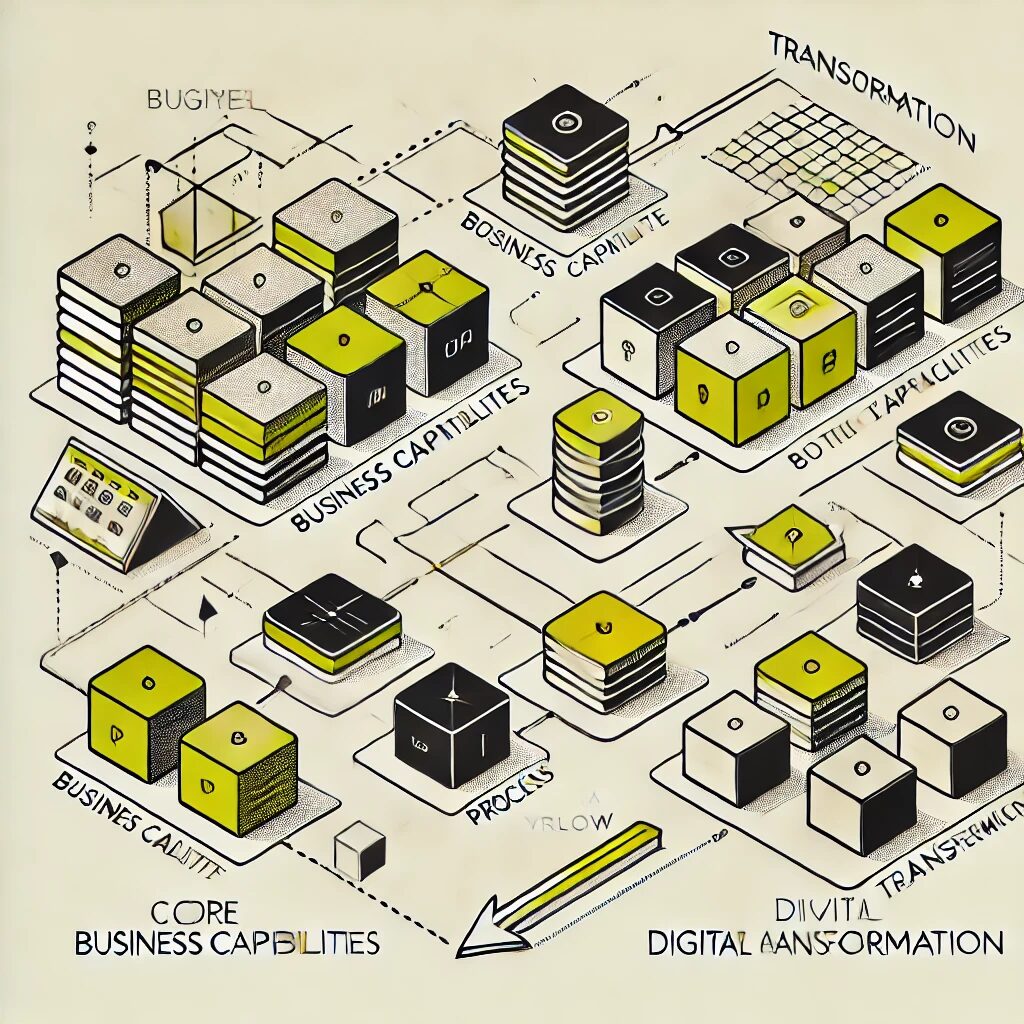
Enterprise Architecture as the Foundation for Oil & Gas Transformation. Architect Today, Transform Tomorrow: Building the Digital Energy Enterprise.
The oil and gas industry stands at a pivotal crossroads, facing unprecedented challenges from volatile commodity prices, changing demand patterns, sustainability imperatives, and intensifying competition. Digital transformation has emerged as the essential pathway to navigate these challenges, promising enhanced operational efficiency, reduced costs, improved safety, and new business models.
Yet many digital initiatives in the energy sector fall short of expectations, delivering isolated point solutions rather than enterprise-wide transformation. Enterprise Architecture (EA) provides the critical foundation that connects business strategy to digital execution, ensuring technology investments deliver sustainable value. By establishing a coherent blueprint that spans business capabilities, information assets, technology systems, and transformation roadmaps, EA enables oil and gas companies to navigate the digital future with confidence and agility.
1: The Digital Imperative for Oil & Gas
The energy sector faces mounting pressures that make digital transformation not just advantageous but essential for competitive survival and future growth. Enterprise Architecture provides the framework to guide this critical journey.
- Market Volatility Management: Digital capabilities enable rapid adaptation to price fluctuations and demand shifts that have become the norm in global energy markets.
- Operational Excellence Demands: Declining margins and production challenges require sophisticated digital solutions to optimize performance across the hydrocarbon value chain.
- Energy Transition Navigation: The gradual shift toward renewable energy and lower-carbon solutions requires digital capabilities to manage portfolio evolution and new business models.
- Workforce Transformation: The changing demographics of the energy workforce demand digital tools that capture institutional knowledge and enhance productivity of a more tech-savvy generation.
- Competitive Disruption: New market entrants with digital-native approaches threaten traditional operational models, requiring incumbent players to transform or risk obsolescence.
2: The Enterprise Architecture Value Proposition
Enterprise Architecture delivers specific, tangible benefits that address the unique transformation challenges of oil and gas organizations navigating digital change.
- Strategic Alignment: EA ensures technology investments directly support corporate objectives by creating clear traceability from business strategy to digital initiatives.
- Complexity Management: The discipline provides structured approaches to manage the intricate technology landscape resulting from decades of acquisitions and point solutions.
- Risk Reduction: Architectural governance identifies and mitigates technology, security, and integration risks before they impact critical operations or safety.
- Cost Optimization: EA enables rationalization of redundant systems, consolidation of infrastructure, and prioritization of investments to maximize return.
- Transformation Acceleration: A well-defined architecture reduces implementation time by providing clear blueprints for digital initiatives that respect enterprise standards and patterns.
3: The Four Domains of Oil & Gas Enterprise Architecture
A comprehensive EA program for energy companies encompasses four interconnected architectural domains that collectively describe the enterprise and guide its transformation.
- Business Architecture: This domain maps strategic objectives to business capabilities, processes, and organizational structures, ensuring digital initiatives target the capabilities that drive competitive advantage.
- Data Architecture: This domain defines the information assets critical to operations, from reservoir models to customer profiles, ensuring data quality, accessibility, and governance.
- Application Architecture: This domain catalogs and designs the software applications that automate business capabilities, from wellhead monitoring to trading systems, ensuring integration and rationalization.
- Technology Architecture: This domain specifies the infrastructure components, from field devices to cloud platforms, ensuring reliability, scalability, and security for mission-critical operations.
4: Enterprise Architecture for Upstream Digital Transformation
In exploration and production operations, EA provides particular value in connecting operational technology (OT) with information technology (IT) to create integrated digital solutions.
- Digital Oilfield Framework: EA establishes the integrating architecture for sensors, control systems, and analytics platforms that optimize well performance and reservoir management.
- Exploration Data Integration: Architectural standards ensure seismic data, geological models, and historical performance information can be combined for more accurate discovery and development decisions.
- Asset Performance Optimization: EA connects condition monitoring, maintenance management, and production systems to maximize equipment reliability and operational uptime.
- Field Workforce Enablement: The architectural framework ensures field personnel have secure, real-time access to the information and expertise needed for safe, efficient operations.
- Remote Operations Center Design: EA provides the blueprint for integrating multiple data sources and control systems into unified visualization and management capabilities.
5: Enterprise Architecture for Midstream Excellence
For transportation, storage, and wholesale operations, EA creates the integrated framework that ensures reliable movement of hydrocarbons through complex logistics networks.
- Pipeline Management Integration: Architectural patterns connect SCADA systems, maintenance management, compliance monitoring, and logistics planning into a unified pipeline operations platform.
- Terminal Automation Framework: EA ensures terminal management systems integrate smoothly with enterprise financial, inventory, and customer systems for seamless operations.
- Logistics Optimization Platform: The architectural blueprint integrates transportation planning, scheduling, and execution across multiple modes to maximize efficiency and reliability.
- Customer Portal Architecture: EA defines the integration points between operational systems and customer-facing digital platforms for real-time visibility and self-service.
- Wholesale Transaction Management: The architectural framework connects trading, scheduling, billing, and settlement systems to enable straight-through processing of wholesale energy transactions.
6: Enterprise Architecture for Downstream Transformation
In refining, distribution, and retail operations, EA provides the integrated digital backbone to optimize complex manufacturing processes and enhance customer experience.
- Refinery Digital Twin: EA establishes the integration architecture for process simulation, real-time monitoring, and predictive analytics that optimize refinery operations.
- Supply Chain Integration: The architectural framework connects demand forecasting, production planning, distribution, and retail operations for end-to-end optimization.
- Retail Network Digitalization: EA provides the blueprint for connecting site systems, payment platforms, loyalty programs, and merchandising into a unified retail management solution.
- Customer Experience Platform: The architectural design integrates customer data, interaction channels, and back-office systems to enable personalized, seamless customer journeys.
- Product Innovation Enablement: EA defines the digital tools and information flows that support rapid development and deployment of new products and services.
Did You Know:
- According to a 2023 Gartner study, oil and gas companies with mature Enterprise Architecture practices achieved 32% higher success rates for digital transformation initiatives compared to organizations with ad hoc approaches to architecture.
7: Data-Driven Energy Enterprise
Enterprise Architecture provides the essential framework for transforming oil and gas companies into data-driven organizations that leverage information as a strategic asset.
- Data Governance Framework: EA establishes the structures, roles, and processes for ensuring data quality, security, and compliance across the enterprise.
- Master Data Management: The architectural approach defines authoritative sources for critical data domains like wells, facilities, customers, and products to ensure consistency.
- Analytics Architecture: EA provides the blueprint for transforming operational data into actionable insights through integrated data platforms and advanced analytics.
- Real-Time Data Integration: The architectural patterns enable the capture and processing of streaming data from field sensors, market feeds, and operational systems.
- Data Ethics and Privacy: EA ensures appropriate controls and transparency for data usage, particularly for customer information and emerging applications of artificial intelligence.
8: Cloud Transformation for Oil & Gas
Enterprise Architecture guides the strategic adoption of cloud technologies in oil and gas companies, ensuring security, performance, and business value.
- Cloud Strategy Alignment: EA ensures cloud adoption decisions support business priorities and address the unique requirements of energy operations.
- Hybrid Architecture Design: The architectural framework defines which workloads belong in public cloud, private cloud, or traditional infrastructure based on security, performance, and cost considerations.
- Cloud Integration Patterns: EA establishes standard approaches for connecting cloud-based applications with on-premises systems to maintain operational continuity.
- Cloud Governance Framework: The architectural discipline defines policies, standards, and controls that manage cloud sprawl and ensure compliance with industry regulations.
- Edge Computing Integration: EA provides the blueprint for distributing computing capabilities between central clouds and remote facilities to optimize performance for field operations.
9: Cybersecurity Architecture for Critical Infrastructure
Enterprise Architecture integrates security into the foundational design of energy systems, protecting critical infrastructure and sensitive information.
- Security by Design: EA embeds security requirements into the earliest stages of solution design rather than applying them retrospectively.
- OT/IT Security Convergence: The architectural approach addresses the unique security challenges of connecting operational technology systems with enterprise IT networks.
- Identity and Access Framework: EA establishes consistent patterns for authenticating users and controlling access across diverse systems and environments.
- Threat Detection Architecture: The security blueprint defines how monitoring tools, analytics, and response processes work together to identify and mitigate cyber threats.
- Compliance Architecture: EA ensures regulatory requirements for critical infrastructure protection are consistently implemented across all systems and facilities.
10: The Enterprise Architecture Operating Model
Successful EA programs in oil and gas companies require an effective operating model that balances governance with agility and delivers tangible business value.
- Governance Framework: EA establishes clear decision rights, review processes, and accountability structures that ensure architecture quality without impeding business agility.
- Federated Operating Model: The organizational approach balances centralized standards with domain-specific expertise across business units and technical disciplines.
- Value Measurement: EA implements metrics and reporting that demonstrate the business impact of architectural governance in terms of cost savings, risk reduction, and strategic enablement.
- Capability Development: The operating model includes structured approaches to building architectural skills and awareness throughout the organization, not just within the EA team.
- Tool Environment: EA provides appropriate repositories, modeling tools, and collaboration platforms that make architectural information accessible to stakeholders across the enterprise.
11: Enterprise Architecture for Operational Technology
Oil and gas companies must address the unique architectural challenges of operational technology systems that directly control physical processes and equipment.
- OT Reference Architecture: EA establishes standard patterns for SCADA systems, distributed control systems, and other operational technologies across diverse facilities.
- OT/IT Convergence Framework: The architectural approach defines secure integration points between operational and enterprise systems to enable digital oilfield solutions.
- Industrial IoT Blueprint: EA provides the architectural patterns for connecting field devices, edge processing, and central analytics to enable real-time optimization.
- OT Lifecycle Management: The architectural discipline addresses the extended lifecycles of operational systems, ensuring supportability and security for decades-old technologies.
- Safety-Critical System Governance: EA establishes special governance processes for systems that impact process safety, ensuring changes don’t compromise operational integrity.
12: Enterprise Architecture for Energy Transition
As oil and gas companies evolve their portfolios toward lower-carbon energy, EA provides the framework for developing new capabilities while optimizing traditional operations.
- Portfolio Evolution Support: EA enables companies to develop architectural blueprints for new business areas like renewable energy, hydrogen, and carbon capture.
- Digital Sustainability Platform: The architectural framework integrates emissions monitoring, carbon accounting, and sustainability reporting across the enterprise.
- Hybrid Business Models: EA supports the development of new digital capabilities that complement traditional hydrocarbon businesses, such as electric vehicle charging and energy-as-a-service.
- Technology Reuse Strategy: The architectural approach identifies existing capabilities and technologies that can be repurposed to support new energy businesses.
- Innovation Acceleration: EA provides sandbox environments and experimental zones where new technologies can be tested without compromising operational systems.
13: Enterprise Architecture Maturity Journey
Oil and gas companies typically evolve their EA practice through several maturity stages, each delivering increasing value to the organization.
- Foundation Building: The initial stage focuses on documenting the current architecture, establishing basic standards, and delivering quick wins that demonstrate value.
- Strategic Alignment: As maturity increases, EA shifts focus to ensuring technology investments directly support strategic objectives and business capabilities.
- Transformation Enablement: At higher maturity levels, EA becomes a key driver of digital transformation, providing the blueprints and roadmaps for major change initiatives.
- Business Innovation: The most mature EA practices actively contribute to business innovation, identifying how emerging technologies can create competitive advantage.
- Ecosystem Orchestration: At the highest maturity level, EA expands beyond enterprise boundaries to architect digital ecosystems that connect partners, suppliers, and customers.
14: Enterprise Architecture Implementation Approach
Implementing effective EA in oil and gas companies requires a pragmatic approach that delivers incremental value while building toward a comprehensive capability.
- Value-Focused Initiation: Begin with high-priority business needs or pain points rather than attempting comprehensive documentation of the entire enterprise.
- Business Architecture First: Start with mapping strategic objectives to business capabilities before diving into detailed technical architectures.
- Pattern-Based Development: Create reusable solution patterns that can be applied consistently across similar business scenarios rather than designing each solution from scratch.
- Reference Architecture Creation: Develop industry-specific reference architectures that incorporate oil and gas best practices and standards.
- Continuous Communication: Maintain ongoing stakeholder engagement through accessible deliverables, regular updates, and business-focused messaging.
Did You Know:
- Implementation Reality: According to a recent McKinsey survey, while 89% of oil and gas executives cite digital transformation as a top strategic priority, only 37% of companies have established the architectural foundations needed to scale digital initiatives beyond isolated proof-of-concepts.
15: Future of Enterprise Architecture in Energy
The EA discipline continues to evolve as oil and gas companies face new challenges and opportunities in an increasingly digital, decarbonizing energy landscape.
- Ecosystem Architecture: EA is expanding beyond enterprise boundaries to model complex partner networks and industry platforms that characterize the future energy system.
- Autonomous Operations Support: The discipline is evolving to provide frameworks for AI-enabled autonomous operations that minimize human intervention in routine tasks.
- Quantum-Ready Architecture: Forward-looking EA practices are preparing for the impact of quantum computing on areas like reservoir simulation, materials science, and optimization.
- Sustainable Technology Governance: EA is incorporating environmental impact considerations into technology selection and architecture decisions.
- Digital Twin Integration: The discipline is establishing frameworks for connecting multiple digital twins across assets, processes, and customers into integrated enterprise models.
Takeaway
Enterprise Architecture provides the essential foundation for successful digital transformation in oil and gas companies by creating clear connections between business strategy and technology implementation. By establishing coherent blueprints across business capabilities, information assets, application systems, and technology infrastructure, EA enables organizations to manage complexity, reduce risk, optimize costs, and accelerate change. Companies that invest in mature EA practices are better positioned to navigate the volatile energy landscape, optimize current operations through digital technologies, and build the new capabilities needed for the energy transition. EA delivers practical value rather than a theoretical exercise by guiding technology decisions that directly support business objectives and enable sustainable competitive advantage.
Next Steps
- Assess Your Architectural Maturity: Evaluate your organization’s current EA capabilities against industry benchmarks and identify priority improvement areas.
- Connect Architecture to Strategy: Ensure your EA program directly supports strategic objectives by mapping digital initiatives to business capabilities and value drivers.
- Establish Governance Foundations: Implement basic architectural governance processes that ensure technology decisions align with enterprise standards and directions.
- Develop Priority Reference Architectures: Create blueprints for high-value digital domains like IoT, analytics, or cloud that guide consistent implementation across projects.
- Build Cross-Functional Engagement: Establish regular touchpoints with business leaders, project teams, and technology specialists to maintain alignment and demonstrate EA value.



